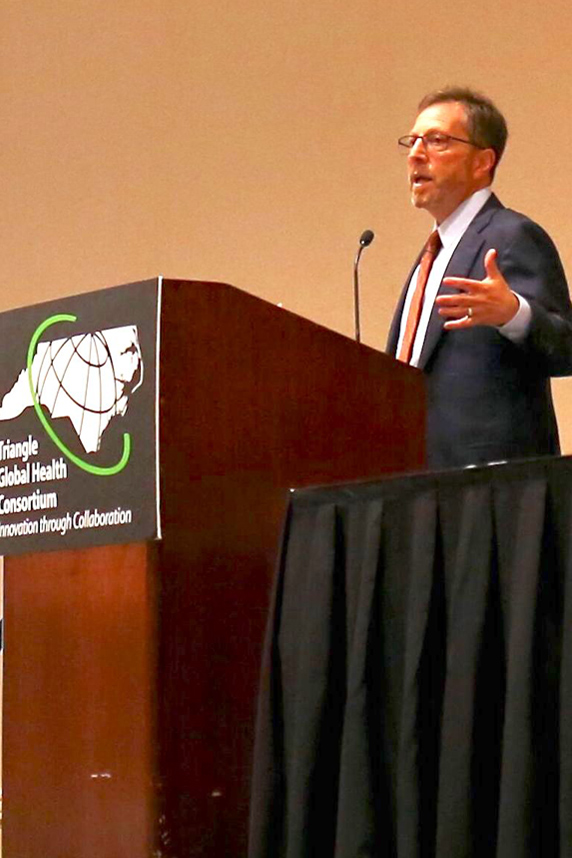Roughly 330 scientists, policy experts, biotechnology leaders, and college students attended the Triangle Global Health Annual Conference Oct. 16, co-sponsored by NIEHS.
The meeting, held in Durham, North Carolina, focused on One Health — the idea that human, animal, and environmental health are interconnected.
The Triangle Global Health Consortium, which partners with nearby researchers, companies, nonprofits, and government entities to improve health worldwide, hosted the event.
Pollution and disease
During her keynote address, NIEHS Scientist Emeritus Linda Birnbaum, Ph.D., emphasized the importance of studying the natural world through a One Health lens. For example, health effects in animals can provide insight into potential effects in humans.
“If you see something happening in fish, and you also see it happen, say, in birds, and you also see it happening in turtles, and you see it happening in certain kinds of mammals, why wouldn’t we think that at least some people would be susceptible or have the same [biological] pathway?” she said.
Birnbaum shared World Health Organization data connecting almost one-fourth of all global deaths each year to environmental issues such as air, water, and soil pollution. Such pollution often hits low-income countries hardest, resulting in millions of lives lost.
She also noted that around the world, environmental problems contribute to more than 100 diseases and injuries.
“Chronic noncommunicable diseases are the largest cause of morbidity and mortality in these populations, and we need to begin to address what is causing that so we can prevent obesity, diabetes, heart disease, cancer, and so on,” Birnbaum added.
Embracing change
 “[Your] children and their children are going to be occupying this space by the time we come to the end of this century. What does that world look like? Because it’s certainly not going to look like the world we occupy today,” said Carroll. (Photo courtesy of Jesse Saffron)
“[Your] children and their children are going to be occupying this space by the time we come to the end of this century. What does that world look like? Because it’s certainly not going to look like the world we occupy today,” said Carroll. (Photo courtesy of Jesse Saffron)In a second keynote address, Dennis Carroll, Ph.D., of Texas A&M University, discussed what he called megatrends that will alter the course of the 21st century.
He pointed to population growth, demographic shifts, urbanization, climate change, land use, and technological innovation. By 2100, he said, the world population will increase by 5 billion.
“You can’t have that kind of intensified footprint without impacting the global environment in a way that really comes back and impacts us as a species. It’s a hugely interactive dynamic,” Carroll explained.
But Carroll urged the audience to view future challenges as opportunities. “We’ll have transformative technologies that will bring us closer together and revolutionize our ability to solve problems,” he said.
When disaster strikes
Kimberly Thigpen Tart, J.D., of the NIEHS Office of Policy, Planning, and Evaluation, moderated a panel titled “Climate Change — The Ultimate One Health Scenario.”
She introduced Aubrey Miller, M.D., NIEHS senior medical advisor, who discussed the institute’s involvement in the National Institutes of Health (NIH) Disaster Research Response Program. The initiative helps communities affected by natural disasters, which have been on the rise in recent years, more quickly collect and synthesize critical information.
The meeting also featured another panel, 12 breakout sessions, 45 posters, 20 exhibits, and other presentations. Here is a sample of topics.
 “Each disaster presents new issues and uncertainties,” said Miller. (Photo courtesy of S.P. Murray)
“Each disaster presents new issues and uncertainties,” said Miller. (Photo courtesy of S.P. Murray)- “Reach the People: How to Communicate Global Health Issues and Solutions.”
- “Public-Private Partnership Models Driving Infectious Disease Innovation.”
- “A One Health Approach to Understanding Ticks and Tickborne Illness in North Carolina.”
- “Trouble in Paradise — One Health in the Galapagos Islands.”
Team effort
Thigpen Tart and Heather Henry, Ph.D., health scientist administrator for the Superfund Research Program, worked on the conference planning committee.
Trisha Castranio, program analyst in the institute’s Global Environmental Health program, served as liaison. She and Abee Boyles, Ph.D., health scientist administrator in the Population Health Branch, staffed the NIEHS exhibit. Amy Wang, Ph.D., health scientist in the National Toxicology Program, participated in various discussions during the day.
(Jesse Saffron, J.D., is a technical writer-editor in the NIEHS Office of Communications and Public Liaison.)
Source link
factor.niehs.nih.gov

